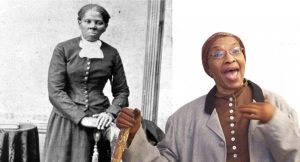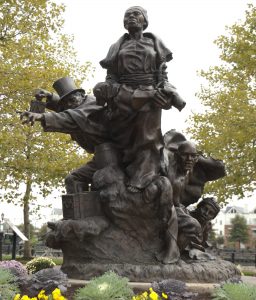An interview with Kathryn Harris Regarding Her Portrayal of Harriet Tubman

Sara Gabbard: Your first person portrayal of Harriet Tubman is in a class by itself. What led you to this method of presentation?
Kathryn Harris: I have found that audiences remember more content or information from a first person presentation than from reading or seeing a video. There is the opportunity to interact with the presenter, to ask questions… My first foray into first person presentation was at our local historical society cemetery walk when I made Phoebe Florville, the wife of William Florville (“Billy the Barber,” Mr. Lincoln’s Springfield barber and friend), come alive. My friend and former colleague at the Abraham Lincoln Presidential Library (formerly the IL State Historical Library (ISHL)) who is the Director of Shows helped me develop and refine my presentations of both Phoebe and Harriet.
SG: I have never attended an event in which there were so many questions from the audience after your official presentation concluded. To what do you attribute this response?
KH: I cannot include everything in my monologue, so I leave time for the audience to ask questions that they want answered. Because of that, I have to be as prepared and as knowledgeable as I can possibly be. That preparation comes from research, including the old-fashioned way: reading books.
When I began presenting as Harriet, I read everything I could find in the ISHL collection and on the internet…this was in the late 1990s. Since then, I have also read the works of Catherine Clinton, Kate Clifford Larson, Jean Humez, and Beverly Lowry. I’ve also read Harriet’s 1869 biography by Sarah H. Bradford: Scenes in the Life of Harriet Tubman. I never know what the audience will ask, so I try to be as prepared as I can be.
SG: Please describe Tubman’s journey as she escaped from slavery. Who helped her along the way?
KH: Even though she “took” her freedom, Harriet had help from many unnamed abolitionists. She escaped from Dorchester County, Maryland (Brodess plantation) to Philadelphia where she met William Still, a conductor and stationmaster on the Underground Railroad. Still, who was black, was the Secretary to the Vigilance Society in Philadelphia. He recounts many of those who passed through his doors on the road to freedom in his seminal work: The Underground Railroad: A Record of Facts, published in Philadelphia by Porter and Coates in 1872.
SG: How did she first become involved in helping slaves escape?
KH: Once Harriet reached freedom in Philadelphia, she wanted others in her family to enjoy the “sweet taste of freedom” so she went back to Dorchester County. She took her brothers and their families, and eventually her parents to freedom. In between, it is said that she made thirteen trips.
SG: How did slaves know where/when she would be available?
KH: Harriet, who was born Araminta Ross, the daughter of Harriet Green Ross and Benjamin Ross, would send word by trusted friends that she was going to be at a certain place at a certain time, and if you wanted to join her on the “freedom line”, be there. There were, of course, no signs, posters, etc. as Harriet was illiterate, as were most slaves. It was against the law to teach a slave to read and write. (Harriet was called “Minty” as a child; she took the name of Harriet when she took her freedom in order to honor her mother.)
SG: When Tubman led slaves to safety, did she always have a definite plan, or did she have to improvise, depending upon the circumstances surrounding each trip?
KH: Harriet was a smart woman. How foolish would it be for her to go the same way all the time as slave catchers and patrollers were always looking for her? It is my thought that she was so familiar with the area between Dorchester County and Philadelphia that she knew different ways to get there…even in the swamps and marshy places. I am confident that she improvised, depending on the needs of the moment.
SG: Did she have people “along the way” who helped her?
KH: Harriet knew, or knew folks who knew, people who were abolitionists. One such person that she knew for sure was Thomas Garrett, a Quaker abolitionist in Wilmington, DE. Garrett sheltered more than 2,500 fugitives at this home/property. In 2012, a monument to these two fighters for freedom was unveiled in a riverfront park in Wilmington. Readers can Google “Unwavering Courage in the Pursuit of Freedom” to see an image of the monument, to learn more about their relationship, and to learn about the sculptor (Mario Chiodo).

SG: I believe that Harriet Tubman was illiterate. Did other people record her journeys?
KH: Harriet was indeed illiterate. William Still recorded some of her stories in his book and Sarah H. Bradford recorded her life story in: Scenes in the Life of Harriet Tubman (Auburn: W.J. Moses, Printer, 1869). Harriet, the Moses of Her People (Lockwood and Sons, New York, 1886) was also written by Bradford.
SG: Can you estimate how many slaves she rescued? What was the average number participating in each trip?
KH: In elementary school, I was taught that Harriet freed 300 slaves, but recent scholarship has reduced that number to about 70. To me, the number is immaterial because if she only led ONE to freedom, that was one less enslaved person. Consider that in 1860, there were nearly four million held in bondage. Escapes via the Railroad have been estimated to be about 10,000, so… Readers who want to learn more can visit the library or Google books for resources by/about Levi Coffin, the President of the UGRR.
SG: What happened to Harriet Tubman after the Civil War ended?
KH: At the close of the War, she worked in the Freedmen’s Bureau and eventually returned to Auburn, New York, where she had purchased a house and opened its doors to former elderly slaves. Harriet died there on March 10, 1913…she was likely ninety years old or so. She also married Nelson Davis, whom she’d met while working in The Bureau.
SG: Were people aware of her “crusade” during the War?
KH: By the time the War had come, she’d ceased her work on the UGRR as she served as a scout, spy, and nurse for the Union Army. She was unassuming and no one would ever expect her to be a spy or scout or an agent for Union Generals. She was successful at this task as well. She led a raid on a plantation along the Combahee River with Union Generals, burned acres of crops and freed nearly 700 enslaved persons.
SG: Has history treated Harriet Tubman fairly?
KH: She is getting the recognition she deserves with the publication of academic/scholarly biographies. There are scores of children’s books about her and school children—black and white— admire her for her bravery and persistence and commitment to her belief about FREEDOM. Also, a major motion picture debuted in November 2019: Harriet. Cynthia Erivo, an actress from the UK, will star in the lead role. Eventually, an image of Harriet Tubman will appear on our $20 bills.
[Kathryn Harris is the former Library Services Director at the Abraham Lincoln Presidential Library and Museum (Springfield, Illinois) and Past President of the Abraham Lincoln Association.]
